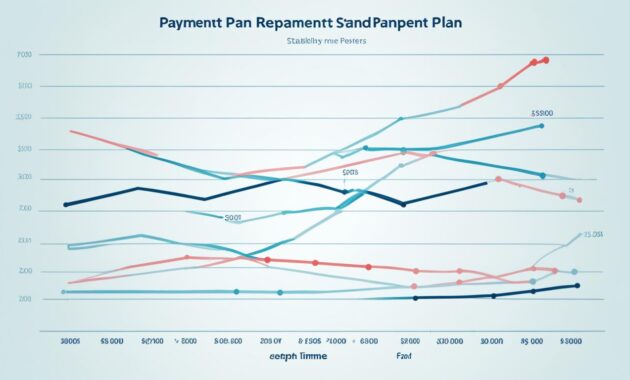Navigating the complex landscape of student loan repayment can be daunting, but it’s crucial for managing your debt effectively and exploring opportunities for relief. This article explores the various options available, including flexible income-driven plans, loan forgiveness programs, and consolidation strategies. Whether you have federal or private student loans, understanding your repayment plan options is essential for maintaining financial stability and achieving your long-term goals.
From the standard 10-year repayment plan to more flexible income-driven options, the article will cover the key features and eligibility requirements of each repayment plan. This information will empower you to select the best option for your unique financial situation, whether you’re seeking more affordable monthly payments, the potential for loan forgiveness, or the ability to consolidate multiple loans into a single, simplified repayment schedule.
Key Takeaways
- Explore the diverse range of student loan repayment plans, including standard, income-driven, and consolidation/refinancing options.
- Understand the eligibility requirements and potential benefits of each repayment plan, such as lower monthly payments or loan forgiveness.
- Assess your financial situation and select the repayment plan that best fits your needs, whether you have federal or private student loans.
- Stay informed about the latest developments in student loan policies and be prepared to adjust your repayment strategy as your financial circumstances evolve.
- Utilize available resources and tools to navigate the student loan repayment process and make informed decisions about your debt management.
Understanding Student Loan Repayment Plans
As a student loan borrower, it’s crucial to understand the different types of loans and the repayment options available to you. Federal student loans, such as Direct Subsidized and Unsubsidized Loans, as well as PLUS Loans, typically offer more flexible repayment plans compared to private student loans. Choosing the right repayment strategy can significantly impact your monthly payments, interest rates, and eligibility for forgiveness or deferment programs.
Types of Student Loans
Student loans can be categorized into two main types: federal student loans and private student loans. Federal student loans are funded by the government and often come with more borrower-friendly features, such as income-driven repayment plans and potential loan forgiveness. On the other hand, private student loans are offered by banks, credit unions, and other financial institutions, and generally have less flexible repayment options.
Importance of Repayment Plans
Repayment plans play a crucial role in managing your student loan debt. The type of repayment plan you choose can determine your monthly payments, the total amount you will pay over the life of the loan, and your eligibility for various relief programs. Understanding the different student loan repayment plans, including federal student loans and private student loans, can help you select the loan types and repayment options that best fit your financial situation.
Standard Repayment Plan
The standard repayment plan is the default option for most federal student loans. Under this plan, borrowers make fixed monthly payments over a 10-year repayment term, with the goal of fully repaying the loan during that time. This straightforward approach to student loan repayment provides predictability and consistency, helping borrowers stay on track with their financial obligations.
The standard repayment plan offers several advantages, including:
- Fixed monthly payments that remain the same throughout the repayment term, making it easier to budget and plan for loan payments.
- A 10-year repayment term, which is relatively short compared to other plans, allowing borrowers to become debt-free more quickly.
- The ability to fully repay the loan within the 10-year period, providing a clear endpoint for the debt.
However, the standard repayment plan may not be the best fit for all borrowers, particularly those with limited income or other financial constraints. In such cases, alternative student loan repayment plans, such as income-driven options, may be more suitable to ensure affordable monthly payments and long-term financial stability.

student loan repayment plans
When it comes to managing student loan debt, income-driven repayment plans can provide significant relief and flexibility. These plans, including the Income-Based Repayment (IBR) plan, Pay As You Earn (PAYE), and Revised Pay As You Earn (REPAYE), tie a borrower’s monthly payments to their discretionary income, making them a valuable option for those with high debt-to-income ratios or fluctuating incomes.
Income-Based Repayment Plan (IBR)
The Income-Based Repayment (IBR) plan is designed to make monthly student loan payments more manageable. Under IBR, your monthly payment is capped at 10-15% of your discretionary income, and any remaining balance is eligible for forgiveness after 20-25 years of qualifying payments. This plan can be particularly beneficial for borrowers with high debt levels relative to their income, as it can significantly reduce their monthly obligations.
Pay As You Earn (PAYE)
The Pay As You Earn (PAYE) plan is another income-driven option that calculates monthly payments based on a borrower’s discretionary income. PAYE limits payments to 10% of discretionary income and offers loan forgiveness after 20 years of qualifying payments. This plan can be a valuable choice for borrowers with a high debt-to-income ratio, as it provides more affordable monthly payments and the potential for long-term debt relief.
Revised Pay As You Earn (REPAYE)
The Revised Pay As You Earn (REPAYE) plan is a refinement of the PAYE plan, extending income-driven repayment options to a broader group of borrowers. Under REPAYE, monthly payments are capped at 10% of discretionary income, and any remaining balance is eligible for forgiveness after 20-25 years, depending on the type of loans. REPAYE can be especially helpful for borrowers with fluctuating incomes or a growing family, as it provides more flexibility and potential for long-term debt relief.
These income-driven repayment plans can be invaluable tools for managing student loan debt, offering more affordable monthly payments and the opportunity for loan forgiveness. By carefully considering your financial situation and eligibility, you can select the plan that best fits your needs and provides the most effective path to becoming debt-free.
Income-Contingent Repayment Plan (ICR)
The Income-Contingent Repayment (ICR) plan is another income-driven option available to federal student loan borrowers. Under the ICR plan, your monthly payments are calculated based on your income, family size, and the total amount of your federal student loans. This plan can be a particularly good choice for borrowers who may not qualify for other income-driven repayment plans, as it offers the potential for loan forgiveness after 25 years of qualifying payments.
Eligibility Requirements
To be eligible for the ICR plan, you must have federal Direct Loans, including Direct Subsidized Loans, Direct Unsubsidized Loans, Direct PLUS Loans, and Direct Consolidation Loans. Private student loans are not eligible for the ICR plan. Additionally, your monthly payment under the ICR plan must be at least as much as the interest that accrues on your loans each month to ensure that your loan balance does not grow over time.
Loan Forgiveness Options
One of the key benefits of the ICR plan is the potential for loan forgiveness after 25 years of qualifying payments. If you have not fully repaid your loans by the end of the 25-year repayment period, the remaining balance may be eligible for forgiveness. It’s important to note that any forgiven amount may be considered taxable income, so it’s crucial to plan accordingly.
| Key Features of the Income-Contingent Repayment (ICR) Plan |
|---|
| Loan Eligibility: Federal Direct Loans, including Subsidized, Unsubsidized, PLUS, and Consolidation Loans |
| Payment Calculation: Based on your income, family size, and total federal student loan amount |
| Repayment Term: 25 years |
| Loan Forgiveness: Remaining balance may be forgiven after 25 years of qualifying payments |
| Potential Tax Implications: Forgiven amount may be considered taxable income |

Loan Consolidation and Refinancing
Navigating the complex world of student loan repayment can be daunting, but there are strategies that can provide relief and simplify the process. Two such options are loan consolidation and refinancing, both of which can offer significant benefits for federal and private student loan borrowers.
Benefits of Consolidation
Consolidating multiple federal student loans into a single Direct Consolidation Loan can simplify your repayment journey. This process combines your existing loans into one, potentially lowering your interest rates and extending your repayment terms. Consolidation can also make it easier to manage your monthly payments and explore additional repayment options, such as income-driven plans.
Refinancing Private Student Loans
For private student loan borrowers, refinancing with a private lender can provide opportunities to secure a lower interest rate and adjust your repayment terms. This strategy can lead to reduced monthly payments and potentially save you thousands of dollars over the life of your loan. However, it’s important to carefully consider the tradeoffs, as refinancing federal loans may result in the loss of certain benefits and protections.







